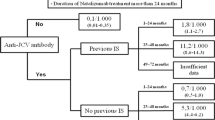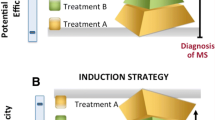Abstract
Cyclophosphamide (Cy) is an alkylating agent used over the past 40 years to halt rapidly progressive forms of multiple sclerosis (MS). High doses of Cy produce marked immunosuppression and an anti-inflammatory immune deviation. Cy is most effective in young patients, with very active MS (frequent relapses, rapid accumulation of disability, and gad+ lesions on brain MRI). Monthly intravenous pulses of Cy for 1 year, followed by bimonthly pulses for the second year are a well-tolerated protocol in MS. Most side effects (mild alopecia, nausea and vomiting, and cystitis) are transient, dose dependent, and reversible. Permanent amenorrhoea and bladder cancer have rarely been described. As second-line therapy, Cy can be used in non-responders to IFN-β or glatiramer acetate. As induction therapy, a short course (6–12 months) of Cy can precede immunomodulatory drugs in selected patients with an aggressive MS onset.
Similar content being viewed by others
References
Weiner HL, Cohen JA (2002) Treatment of multiple sclerosis with cyclophosphamide: critical review of clinical and immunologic effects. Mult Scler 8(2):142–154
Aimard G, Girard PF, Raveau J (1966) Multiple sclerosis and the autoimmunization process. Treatment by antimitotics. Lyon Med 215(6):345–352
Girard PF, Aimard G, Pellet H (1967) Immunodepressive therapy in neurology. Presse Med 75(19):967–968
Hauser SL et al (1983) Intensive immunosuppression in progressive multiple sclerosis. A randomized, three-arm study of high-dose intravenous cyclophosphamide, plasma exchange, and ACTH. N Engl J Med 308(4):173–180
Weiner HL et al (1993) Intermittent cyclophosphamide pulse therapy in progressive multiple sclerosis: final report of the Northeast Cooperative Multiple Sclerosis Treatment Group. Neurology 43(5):910–918
The Canadian Cooperative Multiple Sclerosis Study Group (1991) The Canadian cooperative trial of cyclophosphamide and plasma exchange in progressive multiple sclerosis. Lancet 337(8739):441–446
Likosky WH et al (1991) Intense immunosuppression in chronic progressive multiple sclerosis: the Kaiser study. J Neurol Neurosurg Psychiatry 54(12):1055–1060
Gobbini MI et al (1999) Effect of open label pulse cyclophosphamide therapy on MRI measures of disease activity in five patients with refractory relapsing-remitting multiple sclerosis. J Neuroimmunol 99(1):142–149
Perini P, Gallo P (2003) Cyclophosphamide is effective in stabilizing rapidly deteriorating secondary progressive multiple sclerosis. J Neurol 250(7):834–838
Perini P et al (2006) Mitoxantrone versus cyclophosphamide in secondary-progressive multiple sclerosis: a comparative study. J Neurol 253(8):1034–1040
La Mantia L et al (2002) Cyclophosphamide for multiple sclerosis. Cochrane Database Syst Rev (4):CD002819
Portaccio E et al (2003) Safety and tolerability of cyclophosphamide ‘pulses’ in multiple sclerosis: a prospective study in a clinical cohort. Mult Scler 9(5):446–450
Stillwell TJ, Benson RC Jr (1988) Cyclophosphamide-induced hemorrhagic cystitis. A review of 100 patients. Cancer 61(3):451–457
Talar-Williams C et al (1996) Cyclophosphamide-induced cystitis and bladder cancer in patients with Wegener granulomatosis. Ann Intern Med 124(5):477–484
Radis CD et al (1995) Effects of cyclophosphamide on the development of malignancy and on long-term survival of patients with rheumatoid arthritis. A 20-year followup study. Arthritis Rheum 38(8):1120–1127
Conflict of interest statement
The authors declare that they have no conflict of interest related to the publication of this article.
Author information
Authors and Affiliations
Corresponding author
Rights and permissions
About this article
Cite this article
Rinaldi, L., Perini, P., Calabrese, M. et al. Cyclophosphamide as second-line therapy in multiple sclerosis: benefits and risks. Neurol Sci 30 (Suppl 2), 171–173 (2009). https://doi.org/10.1007/s10072-009-0145-4
Published:
Issue Date:
DOI: https://doi.org/10.1007/s10072-009-0145-4




